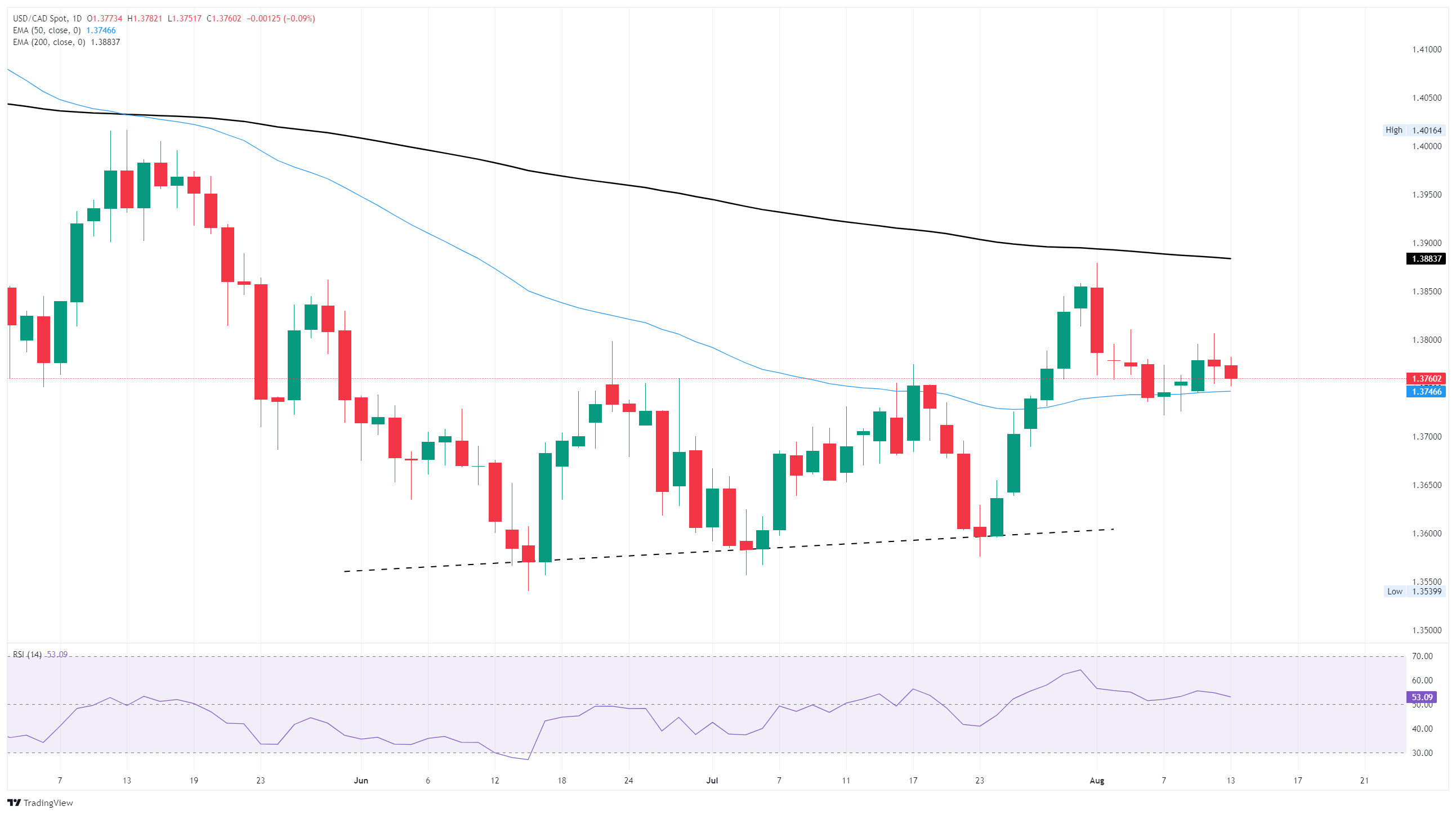Canadian Dollar churns the waters near key averages
- The Canadian Dollar held steady on Wednesday as Loonie traders weigh bets.
- The Bank of Canada acknowledged that the economy may not need further rate cuts.
- Despite a general easing in Greenback flows, the CAD remains trapped in place.
The Canadian Dollar (CAD) spun in a tight circle for the second day in a row on Wednesday as Loonie traders look for signs to move in either direction. The US Dollar (USD) weakened slightly, but a lack of CAD momentum kept the USD/CAD pair trapped near 1.3770.
The Bank of Canada’s (BoC) latest meeting minutes acknowledged that the Canadian economy may not be in a place that requires further interest rate cuts at this time. The BoC’s internal dialogue at the Canadian central bank’s latest interest rate decision neglected to directly note that the last of seven straight interest rate cuts caused a spike in Canadian bond yields and drove up mortgage prices as investors began to question the BoC’s pace of rate cuts.
BoC policymakers instead managed to thread the needle on the observation that the Canadian economy may not be in a place to require further rate cuts, despite ongoing policy turmoil from US tariffs hanging over the Canadian business landscape.
Daily digest market movers: Canadian Dollar treads water, Loonie traders wait for a spark
- The Canadian Dollar has skidded to a halt against the US Dollar, churning chart paper near key moving averages.
- The BoC’s latest meeting minutes revealed little new information, but did confirm to central bank watchers that the BoC is less likely to deliver further interest rate cuts for the time being.
- After key US inflation data this week confirmed that prices may not be accelerating as fast as many had feared, the Producer Price Index (PPI) is on the docket for Thursday.
- Business-level inflation tends to exclude all imported goods, so tariffs are unlikely to have any direct impacts.
- Broad-market bets on three straight rate cuts from the Federal Reserve continue to climb.
Canadian Dollar price forecast
The Canadian Dollar’s newfound consolidation phase against the US Dollar has driven the USD/CAD pair into an uncomfortable midrange. Bids are clattering along the 50-day Exponential Moving Average (EMA) near 1.3750, and price action momentum has drained out of the pair, leaving the Relative Strength Index (RSI) stuck in the middle near 53.00.
USD/CAD daily chart

Canadian Dollar FAQs
The key factors driving the Canadian Dollar (CAD) are the level of interest rates set by the Bank of Canada (BoC), the price of Oil, Canada’s largest export, the health of its economy, inflation and the Trade Balance, which is the difference between the value of Canada’s exports versus its imports. Other factors include market sentiment – whether investors are taking on more risky assets (risk-on) or seeking safe-havens (risk-off) – with risk-on being CAD-positive. As its largest trading partner, the health of the US economy is also a key factor influencing the Canadian Dollar.
The Bank of Canada (BoC) has a significant influence on the Canadian Dollar by setting the level of interest rates that banks can lend to one another. This influences the level of interest rates for everyone. The main goal of the BoC is to maintain inflation at 1-3% by adjusting interest rates up or down. Relatively higher interest rates tend to be positive for the CAD. The Bank of Canada can also use quantitative easing and tightening to influence credit conditions, with the former CAD-negative and the latter CAD-positive.
The price of Oil is a key factor impacting the value of the Canadian Dollar. Petroleum is Canada’s biggest export, so Oil price tends to have an immediate impact on the CAD value. Generally, if Oil price rises CAD also goes up, as aggregate demand for the currency increases. The opposite is the case if the price of Oil falls. Higher Oil prices also tend to result in a greater likelihood of a positive Trade Balance, which is also supportive of the CAD.
While inflation had always traditionally been thought of as a negative factor for a currency since it lowers the value of money, the opposite has actually been the case in modern times with the relaxation of cross-border capital controls. Higher inflation tends to lead central banks to put up interest rates which attracts more capital inflows from global investors seeking a lucrative place to keep their money. This increases demand for the local currency, which in Canada’s case is the Canadian Dollar.
Macroeconomic data releases gauge the health of the economy and can have an impact on the Canadian Dollar. Indicators such as GDP, Manufacturing and Services PMIs, employment, and consumer sentiment surveys can all influence the direction of the CAD. A strong economy is good for the Canadian Dollar. Not only does it attract more foreign investment but it may encourage the Bank of Canada to put up interest rates, leading to a stronger currency. If economic data is weak, however, the CAD is likely to fall.
